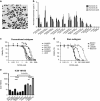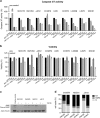Targeting survivin as a potential new treatment for chondrosarcoma of bone
- PMID: 27159675
- PMCID: PMC4945750
- DOI: 10.1038/oncsis.2016.33
Targeting survivin as a potential new treatment for chondrosarcoma of bone
Abstract
Chondrosarcomas are malignant cartilage-forming bone tumors, which are intrinsically resistant to chemo- and radiotherapy, leaving surgical removal as the only curative treatment option. Therefore, our aim was to identify genes involved in chondrosarcoma cell survival that could serve as a target for therapy. siRNA screening for 51 apoptosis-related genes in JJ012 chondrosarcoma cells identified BIRC5, encoding survivin, as essential for chondrosarcoma survival. Using immunohistochemistry, nuclear as well as cytoplasmic survivin expression was analyzed in 207 chondrosarcomas of different subtypes. Nuclear survivin has been implicated in cell-cycle regulation while cytoplasmic localization is important for its anti-apoptotic function. RT-PCR was performed to determine expression of the most common survivin isoforms. Sensitivity to YM155, a survivin inhibitor currently in phase I/II clinical trial for other tumors, was examined in 10 chondrosarcoma cell lines using viability assay, apoptosis assay and cell-cycle analysis. Survivin expression was found in all chondrosarcoma patient samples. Higher expression of nuclear and cytoplasmic survivin was observed with increasing histological grade in central chondrosarcomas. Inhibition of survivin using YM155 showed that especially TP53 mutant cell lines were sensitive, but no caspase 3/7 or PARP cleavage was observed. Rather, YM155 treatment resulted in a block in S phase in two out of three chondrosarcoma cell lines, indicating that survivin is more involved in cell-cycle regulation than in apoptosis. Thus, survivin is important for chondrosarcoma survival and chondrosarcoma patients might benefit from survivin inhibition using YM155, for which TP53 mutational status can serve as a predictive biomarker.
Figures






Similar articles
-
Effects of a combined therapy of bortezomib and ionizing radiation on chondrosarcoma three-dimensional spheroid cultures.Oncol Lett. 2021 Jun;21(6):428. doi: 10.3892/ol.2021.12689. Epub 2021 Mar 30. Oncol Lett. 2021. PMID: 33868466 Free PMC article.
-
A screening-based approach identifies cell cycle regulators AURKA, CHK1 and PLK1 as targetable regulators of chondrosarcoma cell survival.J Bone Oncol. 2019 Nov 17;19:100268. doi: 10.1016/j.jbo.2019.100268. eCollection 2019 Dec. J Bone Oncol. 2019. PMID: 31832331 Free PMC article.
-
SDF-1/CXCR4 signaling up-regulates survivin to regulate human sacral chondrosarcoma cell cycle and epithelial-mesenchymal transition via ERK and PI3K/AKT pathway.Med Oncol. 2015 Jan;32(1):377. doi: 10.1007/s12032-014-0377-x. Epub 2014 Nov 27. Med Oncol. 2015. PMID: 25428386
-
The clinical approach towards chondrosarcoma.Oncologist. 2008 Mar;13(3):320-9. doi: 10.1634/theoncologist.2007-0237. Oncologist. 2008. PMID: 18378543 Review.
-
Non-Conventional Treatments for Conventional Chondrosarcoma.Cancers (Basel). 2020 Jul 19;12(7):1962. doi: 10.3390/cancers12071962. Cancers (Basel). 2020. PMID: 32707689 Free PMC article. Review.
Cited by
-
Biomarkers of chondrosarcoma.J Clin Pathol. 2018 Jul;71(7):579-583. doi: 10.1136/jclinpath-2018-205071. Epub 2018 Mar 28. J Clin Pathol. 2018. PMID: 29593061 Free PMC article. Review.
-
High-Throughput Screening of Myxoid Liposarcoma Cell Lines: Survivin Is Essential for Tumor Growth.Transl Oncol. 2017 Aug;10(4):546-554. doi: 10.1016/j.tranon.2017.05.007. Epub 2017 Jun 24. Transl Oncol. 2017. PMID: 28654818 Free PMC article.
-
Chondrosarcoma-from Molecular Pathology to Novel Therapies.Cancers (Basel). 2021 May 14;13(10):2390. doi: 10.3390/cancers13102390. Cancers (Basel). 2021. PMID: 34069269 Free PMC article. Review.
-
Effects of a combined therapy of bortezomib and ionizing radiation on chondrosarcoma three-dimensional spheroid cultures.Oncol Lett. 2021 Jun;21(6):428. doi: 10.3892/ol.2021.12689. Epub 2021 Mar 30. Oncol Lett. 2021. PMID: 33868466 Free PMC article.
-
Spheroids as a Type of Three-Dimensional Cell Cultures-Examples of Methods of Preparation and the Most Important Application.Int J Mol Sci. 2020 Aug 28;21(17):6225. doi: 10.3390/ijms21176225. Int J Mol Sci. 2020. PMID: 32872135 Free PMC article. Review.
References
-
- Hogendoorn PCW, Bovee JVMG, Nielsen GP Chondrosarcoma (grades I-III), including primary and secondary variants and periosteal chondrosarcoma. In: Fletcher CDM, Bridge JA, Hogendoorn PCW, Mertens F (eds) IARC. WHO Classification of Tumours of Soft Tissue and Bone 2013, pp 264–268.
-
- Gelderblom H, Hogendoorn PCW, Dijkstra SD, van Rijswijk CS, Krol AD, Taminiau AH et al. The clinical approach towards chondrosarcoma. Oncologist 2008; 13: 320–329. - PubMed
-
- Inwards C, Hogendoorn PCWDedifferentiated chondrosarcoma In: Fletcher CDM, Bridge JA, Hogendoorn PCW, Mertens F (eds) IARC. WHO Classification of Tumours of Soft Tissue and Bone 2013, pp 269–270.
-
- Dantonello TM, Int-Veen C, Leuschner I, Schuck A, Furtwaengler R, Claviez et al. Mesenchymal chondrosarcoma of soft tissues and bone in children, adolescents, and young adults: experiences of the CWS and COSS study groups. Cancer 2008; 112: 2424–2431. - PubMed
-
- Frezza AM, Cesari M, Baumhoer D, Biau D, Bielack S, Campanacci DA et al. Mesenchymal chondrosarcoma: prognostic factors and outcome in 113 patients. A European Musculoskeletal Oncology Society study. Eur J Cancer 2015; 51: 374–381. - PubMed
LinkOut - more resources
Full Text Sources
Other Literature Sources
Research Materials
Miscellaneous

